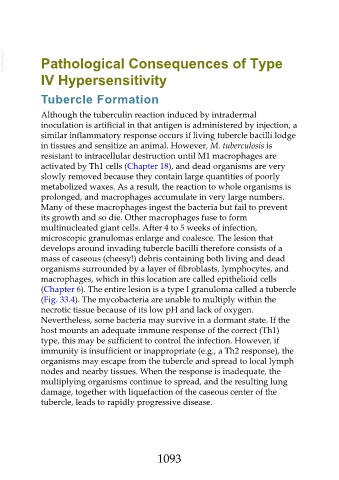Page 1093 - Veterinary Immunology, 10th Edition
P. 1093
VetBooks.ir Pathological Consequences of Type
IV Hypersensitivity
Tubercle Formation
Although the tuberculin reaction induced by intradermal
inoculation is artificial in that antigen is administered by injection, a
similar inflammatory response occurs if living tubercle bacilli lodge
in tissues and sensitize an animal. However, M. tuberculosis is
resistant to intracellular destruction until M1 macrophages are
activated by Th1 cells (Chapter 18), and dead organisms are very
slowly removed because they contain large quantities of poorly
metabolized waxes. As a result, the reaction to whole organisms is
prolonged, and macrophages accumulate in very large numbers.
Many of these macrophages ingest the bacteria but fail to prevent
its growth and so die. Other macrophages fuse to form
multinucleated giant cells. After 4 to 5 weeks of infection,
microscopic granulomas enlarge and coalesce. The lesion that
develops around invading tubercle bacilli therefore consists of a
mass of caseous (cheesy!) debris containing both living and dead
organisms surrounded by a layer of fibroblasts, lymphocytes, and
macrophages, which in this location are called epithelioid cells
(Chapter 6). The entire lesion is a type I granuloma called a tubercle
(Fig. 33.4). The mycobacteria are unable to multiply within the
necrotic tissue because of its low pH and lack of oxygen.
Nevertheless, some bacteria may survive in a dormant state. If the
host mounts an adequate immune response of the correct (Th1)
type, this may be sufficient to control the infection. However, if
immunity is insufficient or inappropriate (e.g., a Th2 response), the
organisms may escape from the tubercle and spread to local lymph
nodes and nearby tissues. When the response is inadequate, the
multiplying organisms continue to spread, and the resulting lung
damage, together with liquefaction of the caseous center of the
tubercle, leads to rapidly progressive disease.
1093

